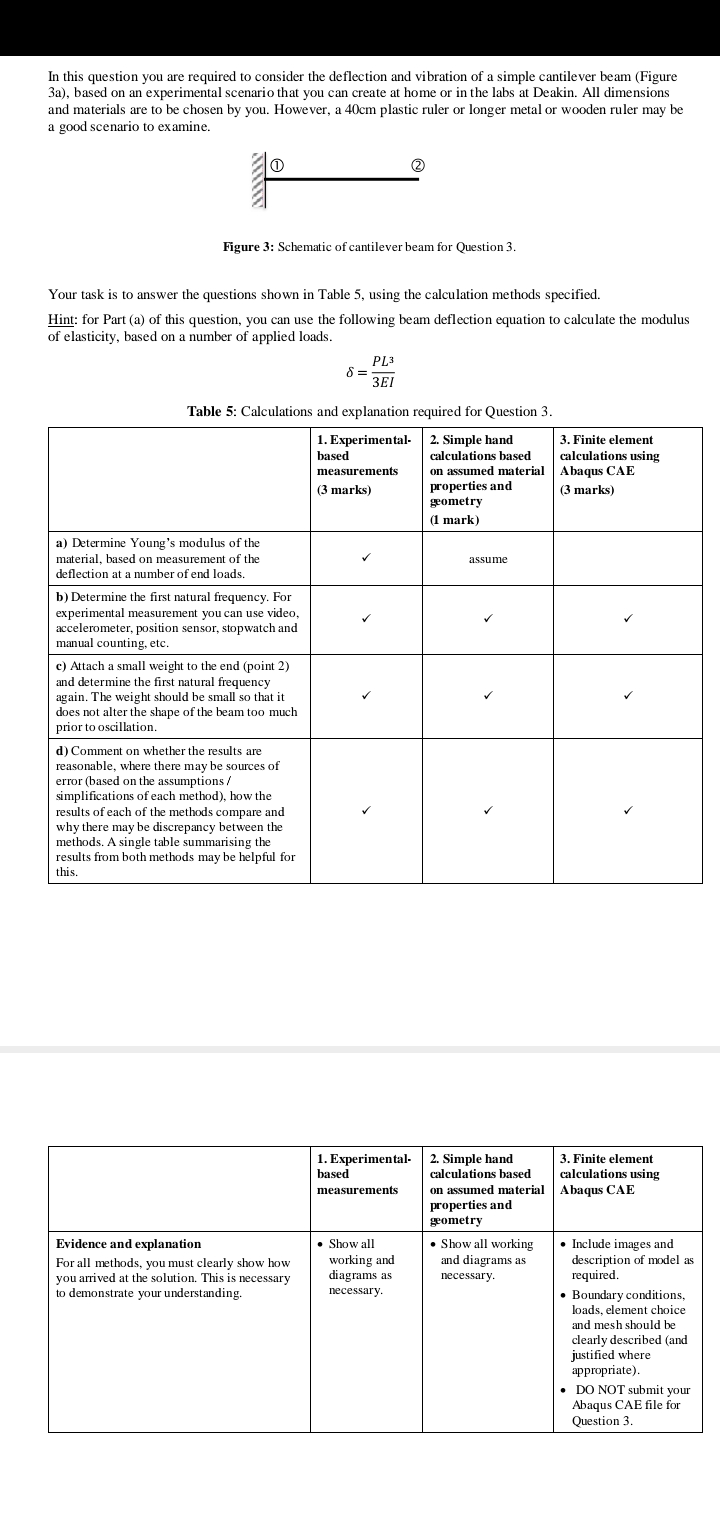In this question you are required to consider the deflection and vibration of a simple cantilever beam (Figure 3a), based on an experimental scenario that you can create at home or in the labs at Deakin. All dimensions and materials are to be chosen by you. However, a 40cm plastic ruler or longer metal or wooden ruler may be a good scenario to examine.
In this question you are required to consider the deflection and vibration of a simple cantilever beam (Figure 3a), based on an experimental scenario that you can create at home or in the labs at Deakin. All dimensions and materials are to be chosen by you. However, a 40cm plastic ruler or longer metal or wooden ruler may be a good scenario to examine.
Elements Of Electromagnetics
7th Edition
ISBN:9780190698614
Author:Sadiku, Matthew N. O.
Publisher:Sadiku, Matthew N. O.
ChapterMA: Math Assessment
Section: Chapter Questions
Problem 1.1MA
Related questions
Question
put alpha = 9

Transcribed Image Text:In this question you are required to consider the deflection and vibration of a simple cantilever beam (Figure
3a), based on an experimental scenario that you can create at home or in the labs at Deakin. All dimensions
and materials are to be chosen by you. However, a 40cm plastic ruler or longer metal or wooden ruler may be
a good scenario to examine.
1)
Figure 3: Schematic of cantilever beam for Question 3.
Your task is to answer the questions shown in Table 5, using the calculation methods specified.
Hint: for Part (a) of this question, you can use the following beam deflection equation to calculate the modulus
of elasticity, based on a number of applied loads.
PL3
8 =
3EI
Table 5: Calculations and explanation required for Question 3.
1. Experimental- 2. Simple hand
based
3. Finite element
calculations based
on assumed material Abaqus CAE
calculations using
measurements
properties and
geometry
(1 mark)
(3 marks)
(3 marks)
a) Determine Young's modulus of the
material, based on measurement of the
assume
deflection at a number of end loads.
b) Determine the first natural frequency. For
experimental measurement you can use video,
accelerometer, position sensor, stopwatch and
manual counting, etc.
c) Attach a small weight to the end (point 2)
and determine the first natural frequency
again. The weight should be small so that it
does not alter the shape of the beam too much
prior to oscillation.
d) Comment on whether the results are
reasonable, where there may be sources of
error (based on the assumptions /
simplifications of each method), how the
results of each of the methods compare and
why there may be discrepancy between the
methods. A single table summarising the
results from both methods may be helpful for
this.
1. Experimental- 2. Simple hand
based
3. Finite element
calculations based
calculations using
on assumed material Abaqus CAE
properties and
geometry
measurements
• Show all
working and
diagrams as
• Include images and
description of model as
required.
• Boundary conditions,
loads, element choice
and mesh should be
Evidence and explanation
For all methods, you must clearly show how
you arrived at the solution. This is necessary
to demonstrate your understanding.
Show all working
and diagrams as
necessary.
necessary.
clearly described (and
justified where
аppropriate).
DO NOT submit your
Abaqus CAE file for
Question 3.
Expert Solution
This question has been solved!
Explore an expertly crafted, step-by-step solution for a thorough understanding of key concepts.
Step by step
Solved in 2 steps with 2 images

Knowledge Booster
Learn more about
Need a deep-dive on the concept behind this application? Look no further. Learn more about this topic, mechanical-engineering and related others by exploring similar questions and additional content below.Recommended textbooks for you

Elements Of Electromagnetics
Mechanical Engineering
ISBN:
9780190698614
Author:
Sadiku, Matthew N. O.
Publisher:
Oxford University Press

Mechanics of Materials (10th Edition)
Mechanical Engineering
ISBN:
9780134319650
Author:
Russell C. Hibbeler
Publisher:
PEARSON

Thermodynamics: An Engineering Approach
Mechanical Engineering
ISBN:
9781259822674
Author:
Yunus A. Cengel Dr., Michael A. Boles
Publisher:
McGraw-Hill Education

Elements Of Electromagnetics
Mechanical Engineering
ISBN:
9780190698614
Author:
Sadiku, Matthew N. O.
Publisher:
Oxford University Press

Mechanics of Materials (10th Edition)
Mechanical Engineering
ISBN:
9780134319650
Author:
Russell C. Hibbeler
Publisher:
PEARSON

Thermodynamics: An Engineering Approach
Mechanical Engineering
ISBN:
9781259822674
Author:
Yunus A. Cengel Dr., Michael A. Boles
Publisher:
McGraw-Hill Education

Control Systems Engineering
Mechanical Engineering
ISBN:
9781118170519
Author:
Norman S. Nise
Publisher:
WILEY

Mechanics of Materials (MindTap Course List)
Mechanical Engineering
ISBN:
9781337093347
Author:
Barry J. Goodno, James M. Gere
Publisher:
Cengage Learning

Engineering Mechanics: Statics
Mechanical Engineering
ISBN:
9781118807330
Author:
James L. Meriam, L. G. Kraige, J. N. Bolton
Publisher:
WILEY